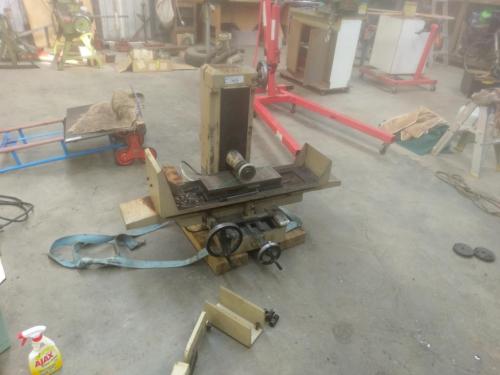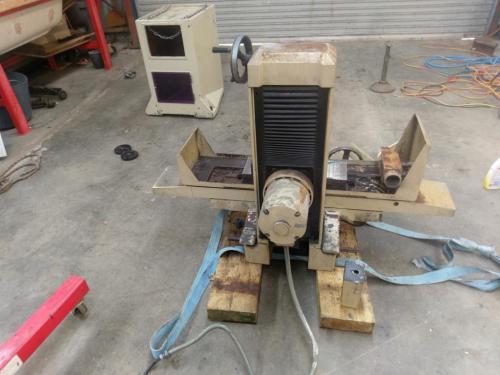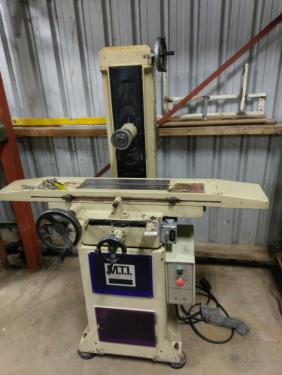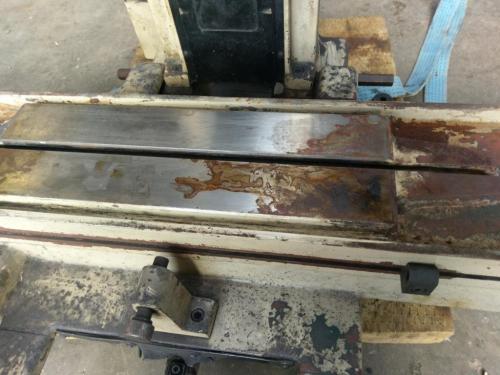05-20-2017, 07:51 AM
This was kind of an impulse purchase at a machine shop clearing sale, it's been something I've thought would be nice to have but I have to admit to very little knowledge and absolutely no experience of surface grinders. Brought it home last Tuesday and spent several hours on Thursday separating the grinder from the base so I could lift it off the trailer and then beginning to clean it up.

The machine was pretty filthy, the base was easy enough to clean with the pressure washer but the grinder itself took all of this afternoon to clean up.



I cleared a suitable space and got the base into position and leveled, then lifted the grinder on and leveled that. Leveling the base with a carpenter's level took probably less than a minute as it has 3 feet. Leveling the grinder itself with a machinist level on the chuck mounting surface took ages but I got there in the end. Got the switchgear housing and the lube unit mounted before calling it a night.

The table runs on balls and the x-axis is driven via a toothed belt. All seems to operate pretty smoothly. I don't plan to strip it down any further than I have done just to give it a basic clean. Still have to clean up the guard arrangement and a few minor bits. Also need to investigate the dust collector unit, there is no plug attached to the power lead so I'm wondering if it was removed due to an electrical fault.
When I removed the chuck, this is what I found underneath.

and the underside of the chuck itself:

Doesn't exactly look like two perfectly mated surfaces, does it?
I've read that the chuck surface should be ground in place after installation. I'm thinking that the underside of the chuck and the mounting surface on the table also need grinding.
My thoughts at this stage are to mount the chuck and get a bit of practice with the machine, just grinding scrap material until I'm reasonably comfortable with it, then do the following:
1; grind the table surface that the chuck sits on
2; mount the chuck upside-down, clamping it down under it's own mag force, and grind the underside
3; mount the chuck to the table and grind the top of the chuck.
I'm very keen to get some feedback from you experienced fellas as to whether this seems like the right approach.
I got a couple of welcome surprises when I started unloading; there was a wheel balancing jig and arbor, a wheel dresser plus the wheel guard that I thought was missing, hiding in the bottom of the machine. I got a bunch of grinding wheels, about 15 or 20 I think, haven't had much of a look at them yet but there are a bunch of different sizes and shapes including a few cup wheels and stuff. Hopefully I'll get a chance to have a better look at them in the next few days and will post some more photos. I'll also have a heap of questions!
The machine was pretty filthy, the base was easy enough to clean with the pressure washer but the grinder itself took all of this afternoon to clean up.
I cleared a suitable space and got the base into position and leveled, then lifted the grinder on and leveled that. Leveling the base with a carpenter's level took probably less than a minute as it has 3 feet. Leveling the grinder itself with a machinist level on the chuck mounting surface took ages but I got there in the end. Got the switchgear housing and the lube unit mounted before calling it a night.
The table runs on balls and the x-axis is driven via a toothed belt. All seems to operate pretty smoothly. I don't plan to strip it down any further than I have done just to give it a basic clean. Still have to clean up the guard arrangement and a few minor bits. Also need to investigate the dust collector unit, there is no plug attached to the power lead so I'm wondering if it was removed due to an electrical fault.
When I removed the chuck, this is what I found underneath.
and the underside of the chuck itself:
Doesn't exactly look like two perfectly mated surfaces, does it?
I've read that the chuck surface should be ground in place after installation. I'm thinking that the underside of the chuck and the mounting surface on the table also need grinding.
My thoughts at this stage are to mount the chuck and get a bit of practice with the machine, just grinding scrap material until I'm reasonably comfortable with it, then do the following:
1; grind the table surface that the chuck sits on
2; mount the chuck upside-down, clamping it down under it's own mag force, and grind the underside
3; mount the chuck to the table and grind the top of the chuck.
I'm very keen to get some feedback from you experienced fellas as to whether this seems like the right approach.
I got a couple of welcome surprises when I started unloading; there was a wheel balancing jig and arbor, a wheel dresser plus the wheel guard that I thought was missing, hiding in the bottom of the machine. I got a bunch of grinding wheels, about 15 or 20 I think, haven't had much of a look at them yet but there are a bunch of different sizes and shapes including a few cup wheels and stuff. Hopefully I'll get a chance to have a better look at them in the next few days and will post some more photos. I'll also have a heap of questions!
Lathe (n); a machine tool used in the production of milling machine components.
Milling Machine (n); a machine tool used in the production of lathe components.
Milling Machine (n); a machine tool used in the production of lathe components.







 I think the machine is now capable of doing accurate work, wish I could say the same thing for the bloke operating it.
I think the machine is now capable of doing accurate work, wish I could say the same thing for the bloke operating it.